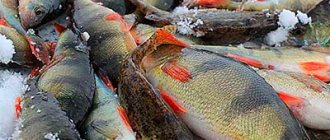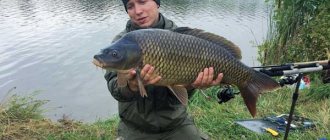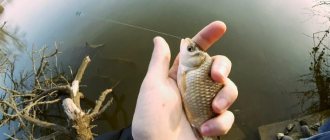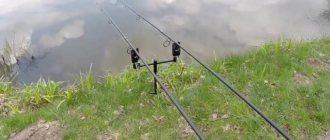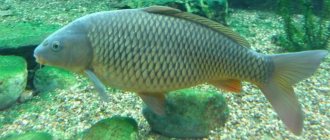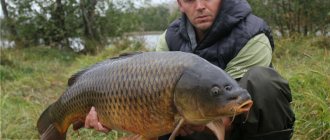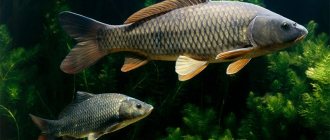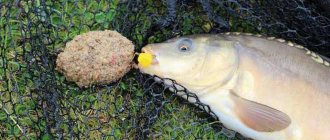The correct bait for the feeder constantly causes controversy and disagreement in the fishing community. This happens due to an excess of information on the Internet aimed at advertising ready-made mixtures, which sometimes misleads novice feeders. Beginners begin to look for the best and most effective working mixture after the bright videos of famous athletes.
Some experienced fishermen with extensive bottom experience fish using spinning rods, filling the feeders with a sticky mixture or even squares of tops so that it lasts longer. All this is wrong and contradicts the correct feeder technique.
The basic basis of the feeder is constant feeding of one point, creating a table and maintaining it in working condition. The right table not only attracts fish, but holds it in place, forcing it to actively search for and eat food at the point.
Feeder bait should not lie in the feeder as a dead weight. On the contrary, the mass should be quickly washed out, but not spill out ahead of time when casting. In order to understand feeder fishing, the approach of “mixing something quickly just to have it” does not work.
You need to immerse yourself as much as possible in the process of preparing bait for the feeder and the technique of use. Proper feeding, feeding itself and the composition of the mixture directly affect the result of feeder fishing. Let's look at how to properly make bait for a feeder with your own hands, use ready-made mixtures and use it all on a pond.
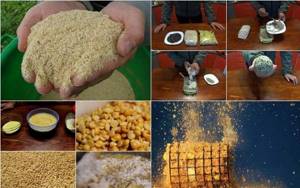
Bait in feeder fishing
When it comes to bait for feeder fishing, the technique itself is important. And the composition of the mixture, its components, as well as correctly configured feeder equipment are tools that allow you to achieve your feeding goals. Different fishing conditions, the presence or absence of a current, the species composition of fish - all this imposes certain nuances on the use of bait and its composition. However, for any conditions there are certain basic points that are specific to feeder fishing.
A point zone is created at a specific point in the water area. The feed is delivered exactly to one point. If already in flight, when casting, the angler sees that the feeder is flying in the wrong direction, the bait should not be allowed to sink to the bottom somewhere near the point - this will distract and scatter the fish over the area. In this case, you should interrupt the flight and twitch to release the feeder in the thickness so that the bait is dispersed in the thickness and does not spoil the feeding area.
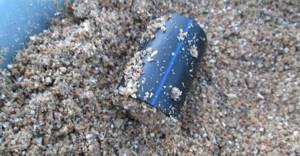
Ground in bait
If you fish in the current, then you need to glue the bait; clay is used for this purpose. It can be bought at a fishing store, and there are quite a large number of different colors on sale. But if you don’t want to spend money, then you should look for clay in a pond. You need to take the clay that is located at the very edge of the water.
When fishing in a standing reservoir, soil can be added to create turbidity, darken the bait and reduce its nutritional value.
It is initially advisable to pass the clay and soil through a sieve in order to get rid of lumps. If we add soil to slightly moistened groundbait, and then carefully moisten it with the help of a basic spray bottle for flowers, we will get balls that, sinking to the bottom, will literally explode. If you add soil to waterlogged bait, so that the soil absorbs all the moisture and no longer needs to be re-moistened, then the result will be a fairly viscous bait that works great in currents.
Feeder Feeding Basics
How much bait you need for fishing with a feeder depends on the time of fishing, the season and the type of fish. Usually this is from 2 to 5 kilograms per active rod, for about 5 hours. For roach in cold water you need just a little bit, a couple of kilograms. For active fishing for large bream, carp and carp in the summer - much more. Large fish like to eat a lot, especially in summer. And in order to stop it at a point, you need to deliver a certain amount of feed particles there.
- Mixing bait for the feeder resembles a ritual, just like measuring the bottom before fishing. Don’t pay attention to the grins of experienced fishermen who abandoned their gear two hours ago, and you are still measuring or stirring the bait.
- When the feeder begins to get the fish, and at a fast pace, these grins are usually replaced by genuine interest. Everything is done carefully and purposefully.
- The preparation of bait for the feeder must be approached consciously - all the components in it and the consistency are not selected by chance, but for a specific purpose, depending on the fishing conditions and the type of fish.
- Further, with experience, this process becomes a habit. Before you make bait for the feeder, you need to understand what is needed in it and why, and how it will all work on the pond.

Starter feeding
After identifying the fishing point, we start feeding. Feeder and bait are inseparable concepts. The name Feeder literally means feeder. Purposefully and calmly we throw 5-15 feeders to a point. Before starting, it is recommended to fill the feeder and place it in water nearby to see how the mixture behaves.
The correct bait should reach the bottom without falling apart as a result of casting. Splashing on the water and passing a layer of water to the bottom. And only then, having fallen into place, the mass should begin to fall apart. We will examine this issue in more detail further, in the section on bait consistency.
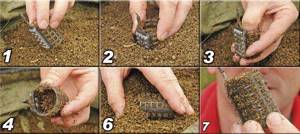
- We do not use a leash with a hook to reduce tangles. After each cast, wait a couple of minutes for the food to get wet, shake it out with sharp jerks with the rod up, and reel in the feeder. And so on up to 15 repetitions.
- At a short distance without flow, feeder bait for whitefish (roach, bream, silver bream) is enough in the amount of 5 small feeders, especially in cold water - you cannot overfeed the fish. When catching large crucian carp or bream in the summer, we cast a lot - up to 15 feeders.
- When purposefully catching large carp or carp, you need even more - up to several kilograms with delivery to the point by boat or bait boat. In still water, you can use special feeding troughs with a large feed capacity, rockets on separate rods - fewer casts will be needed.
- During the current, measuring, feeding and further fishing is best done with one, working feeder. Feeders of different configurations, sizes and weights are carried away by the flow in different ways, and if you change it after feeding, you may simply not get to the desired point during subsequent casts.
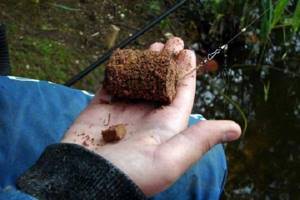
Supplementary feeding during fishing
Calmly and leisurely we feed the point. There is no need to rush to quickly throw the bait on the hook - we are not in a competition. This takes 15-20 minutes. Then you can hang a leash with a hook and cast with bait. At the beginning of fishing, small fish usually gather at the point, so you can put a smaller leash with a hook, with a small bait, one maggot.
If this is not necessary, we immediately throw the ready-made installation onto a large fish - the target of fishing, peas, a bunch of worms or a sandwich. Working and experimenting with bait is an important part of feeder fishing. Read more about feeder nozzles.
The end of the starting feeding does not mean that you need to throw out the feeder and wait until you’re blue in the face for a bite. Feeder is a tempo tackle. When catching leucorrhoea, we recast every 2-3 minutes, checking the bait and refilling the feeder. We continue to feed the fishing point with the feeder. Large fish, especially shallow ones, may be afraid of the splash of the feeder on the water.
For crucian carp, carp, and large bream, we recast less often - once every 7-15 minutes. But we do it anyway - we check the attachment and fill the feeder. For large fish, along with finely dispersed bait, feed particles - peas, corn, pearl barley, maggot or chopped worms - must be delivered to the point. We throw what we catch with. You can mix the feed parts evenly into the bait, or you can stuff them into the middle of the feeder, covering the edges with a sticky mass.
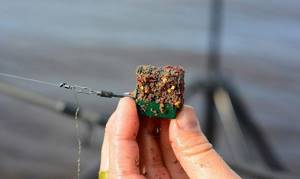
Feeder with small feed capacity
By filling the feeder feeder, the washout time is regulated, depending on the strength of the flow and the consistency of the mass. To reduce this time, we hammer the food loosely, without squeezing too much. In a strong current, we squeeze hard, then the mass will be washed out more slowly in the stream.
It is necessary to crush the food firmly when fishing at great depths - so that the bait reaches the bottom safely and does not fall out somewhere in the depths while the feeder is immersed. Each type of fish has its own characteristics of starting feeding and further feeding. You can familiarize yourself with these nuances in the relevant publications on our website.
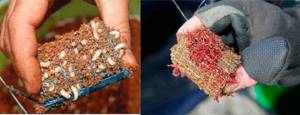
Live component in bait
Bait manufacturing technology
Any porridge for a do-it-yourself feeder should consist of a base and additives, the proportion of which depends on the type of fish, the strength of the current and the season: from 20/80 to 50/50. In order to “interest” aquatic life, only the main ingredient is enough, and the flavoring additions make it stay in the right place, waiting for tasty pieces. The technology for manual production of complementary foods is quite simple: prepare the ingredients, grind them to the desired consistency and stir at home or on site.
The basis
The base creates the necessary (depending on the strength of the current) base consistency to form a noticeable trail in the water and a stable feeding spot that will not be carried away by the flow. The main ingredient should have a fine consistency that creates a tasty cloudy cloud, for this use:
- powdered milk;
- coriander seeds, crushed nuts or seeds;
- fishmeal (fishmeal);
- semolina, small dry cereals;
- crushed bread or pastry;
- cake, compound feed.
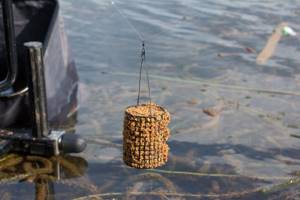
To increase the viscosity, add sugar or flour mixed with water to fishing bait.
Filler
Ingredients of a different taste and with a larger structure added to the base will help keep the fish within the food cloud and force them to look for additional food in this area:
- boiled porridges (rolled oats, corn, semolina, oat flakes);
- bran;
- peas, dry corn;
- halva;
- dough;
- whole grain;
- Broken cookies or breadcrumbs help loosen the mixture well.
Depending on the type of cereal or peas, porridge can be made in the traditional way, steamed for several hours in a thermos, or cooked in the microwave.
To make the “treat” more noticeable to the fish, dyes (preferably natural) are added to it. In summer, fertilizing should be light, and dark formulations should be used in cold water.
Flavor enhancer
In order for feeder bait to interest the fish and arouse its appetite, taste and aroma enhancers are added to the mixture, for example:
- fruit syrups;
- aroma oils;
- honey, caramel;
- coffee, cocoa, chocolate;
- beer;
- vanilla, ginger, cinnamon.
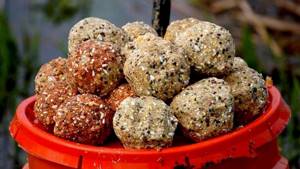
To enhance the taste, it is better to use natural ingredients; fish bite worse on ready-made artificial substitutes. You should not put a lot of flavorings in the food; too strong a smell of the bait can scare away aquatic inhabitants instead of attracting them.
Additives of animal origin
In addition to plant ingredients, it is advisable to add animal products to the bait mixture:
- fresh lard;
- bloodworm;
- crushed worms;
- maggots (live or canned);
- gammarus (mormysh).
Animal supplements should be selected based on the preferences of a particular fish species.
Fishing conditions and bait consistency
To properly mix bait for the feeder, we are guided by a general universal rule. The mass should be loose, but mold when squeezed. The food should not fall out of the feeder during casting and passing through the water column. But after a couple of minutes in the water, the mixture should begin to crumble. This bait is called active. Therefore, very sticky, indelible masses and hard cake cubes (makukha), as in donks, are not used.
The consistency of the bait on the feeder for the flow needs to be heavier, stickier, so that the particles are not carried away by the flow, but are retained at the bottom. However, the mass should still not lie in a single sticky lump. The bait should seem to explode and collapse under the influence of water, settling on the bottom and forming turbidity attractive to fish.
The correct consistency of the bait is achieved by a certain ratio of the binding and loosening parts of the mass and the degree of moisture. All this is done by eye, according to the sensations of your hands during kneading. If the bait turns out to be too viscous and sticky (too many binding components or as a result of waterlogging), add rippers. If it’s too dry and crumbly and doesn’t stick together, add water or a binder.
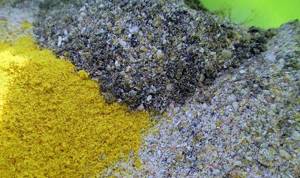
Purchased feeder baits are usually already selected in composition, and we achieve the correct consistency by the degree of moisture. In homemade mixtures, this can be done by changing the ratio of sticky and loosening components.
Sticky adhesives:
- Semolina;
- Fresh finely ground cake;
- Flour;
- Molasses or molasses (due to sugar);
- Ground rolled oats.
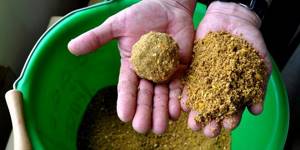
. Loosening components:
- Breadcrumbs;
- Ground confectionery products (cookies);
- Roasted flour or cereal;
- Bran;
- Large feed fraction – grain, pearl barley, live ingredients.
To improve porosity, a sieve with a cell size of 2-4 mm is used. Based on numerous videos on YouTube, it seems that the sieve is used to remove debris and large particles. However, this is a secondary function. The main thing is that when the bait is passed through a sieve, the mass is loosened and a large amount of oxygen enters it. This air remains there when molding into the feeder. In the water, the air begins to rise upward in bubbles, destroying the lump faster and better.

Base and feed fraction
We discussed the physical properties, now let’s touch on the qualitative characteristics of the feeder bait. Some fishermen by ready-made mixture mean store-bought bait. However, this is only the basis of bait, which you can do yourself. The correct feeder mass contains approximately 60% base and 40% coarse feed fraction. This can be boiled pearl barley, peas, corn, animal supplements.
The base is that fine sand that, when absorbing moisture, creates the desired consistency in terms of looseness and stickiness. The feed fraction is needed directly to feed large fish so that they remain at the point. A clean, shallow base can be used to catch small whitefish. For large fish - bream, crucian carp, carp and carp, a sufficient amount of feed elements must be present in the mass.

Base and feed elements
The base may contain various small particles. The more types there are, the better. This is the basis for the action of professional multicomponent mixtures. Different foods contain different amino acids and other substances, which together turn on the feeding reflex in fish. Which of them specifically act on fish at this time is unknown. The chance of such an impact is increased by multiple components.
Laxative elements (peanuts, flax, beets) are also added to the base so that the fish’s digestion is accelerated, and it quickly defecates without stopping feeding and without getting full. The best feeder baits are made with these features in mind. However, you should not rely on them completely. No one has yet created an absolutely universal and working recipe.
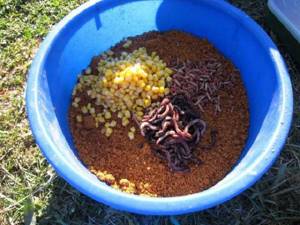
Corn, worms and maggots in feed for large fish
The large feed fraction allows you to cut off small things when fishing on a feeder. At the same time, the base should not become too dusty. For small fish, on the contrary, you need fine-grained, dusty bait. Any groundbait, store-bought or homemade, requires the following approach - separation and understanding of the base and feed fraction. As food particles, you need to use what the fish are used to. These elements should repeat the bait on the hook.
We catch with worms and add their chopped counterparts. The bait is peas or corn - respectively, and these grains must be present in the feed fraction. The ratio of base and feed element is only approximate. For example, feeder porridge is a ready-made set, where millet or pearl barley is the feed, and crackers and finely ground cake are the binding base. You can use store-bought or homemade mixtures as a base, adding grain or live ingredients to it.
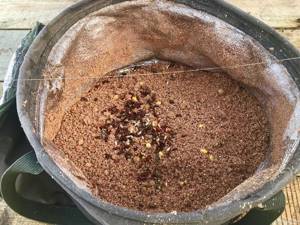
Maggot and casters
Bait recipes for different types of fish
crucian carp
Crucian carp is the most picky and indiscriminate fish in feeding. Preparing porridge for this type is not difficult or finding ingredients. The main thing when catching crucian carp is that the porridge creates turbidity, which the fish will certainly approach.
Recipe No. 1
To make the first mixture we will need:
- Bread crumbs;
- Hercules flakes;
- Cake;
- Compound feed;
- Garlic.
Pour all the ingredients except garlic into a bucket, basin or pan and mix thoroughly. Cut the garlic into small cubes or crush it and mix it with the rest of the bait materials.
Add water, stirring gradually. It is advisable to prepare the bait directly near the reservoir, and also take water from it.
Recipe No. 2
- Bread crumbs;
- Corn grits porridge;
- Boiled pearl barley;
- Cake;
- Bloodworm or worm;
- Coriander.
Mix all materials. Fill with water. Let it brew for 2-3 hours. If necessary, add water or crackers.
Carp
Carp, unlike crucian carp, is very careful in choosing food. Fishing for carp involves the use of certain ingredients. Corn is especially revered by carp; we will use it as a food element.
Recipe No. 1
- Bread crumb;
- Hemp seeds;
- Bran;
- Millet (undercooked);
- Canned corn;
- Corn and soy flour;
- Powdered milk;
- Fruit flavor (Tutti-frutti, peach, strawberry);
Pour all ingredients except flavoring into a bowl and mix. Instead of water, it is recommended to pour corn juice from a can along with flavoring; if there is not enough juice, you can add water as needed.
Recipe No. 2
- Semolina;
- Powdered milk;
- Sugar;
- Peanuts (ground);
- Pet food;
- Corn grits;
- Cake;
- Canned corn and peas;
- Anise oil.
In this recipe, the basis of the bait is semolina and corn grits. It also contains dog or cat food; the food must be dry. The porridge infusion time is 4-5 hours, so that the food softens and the porridge easily forms into balls.
Bream
Bream, like the carp family, prefers a certain bait, in this case it is peas or boiled pasta.
Recipe No. 1
- Millet (boiled);
- Breadcrumbs;
- Sunflower seeds (ground);
- Hemp seeds (steamed);
- Milk powder;
- Bloodworm;
- Canned peas;
- Vanilla, caramel, anise oil.
The principle of preparing this bait is similar to recipe No. 2 for carp; instead of water, it is recommended to add juice from a can of peas mixed with flavorings.
Recipe No. 2
- Bread crumbs;
- Roasted sunflower seeds (ground);
- Bran;
- Boiled peas;
- Chopped coriander.
Chopped coriander is mixed together with the main ingredients.
Perch
Perch is a predator, so the bait for this fish has completely different ingredients in its composition.
Recipe
- Ground white clay;
- Eggshell;
- Fish blood;
- Worms (earth or dung)
- Fish meat.
Preparation:
- Grind the eggshells and mix with clay;
- Dilute the resulting porridge with fish blood;
- Add chopped worms and mix;
- Finally, add finely chopped pieces of fish.
Instead of fish, you can add mussels or crustaceans to the bait.
Carp
Carp belongs to the carp family, so there are no differences in complementary feeding.
Recipe No. 1
- Corn (boiled)
- Peas (canned)
- Barley (boiled);
- Cake;
- Vanilla.
Mix all ingredients in a bowl or saucepan and mix with water. Leave the resulting porridge for 2-3 hours, then add flavoring and mix again.
Recipe No. 2
- Corn;
- Rusks;
- Cake;
- Sunflower seeds;
- Garlic
Add chopped garlic as a flavoring and mix together with all the ingredients, letting it brew for 3-4 hours.
On a note
When fishing for carp and carp, many fishermen use the so-called “drunk corn”.
To get the drunken corn effect we need:
- Corn grains are soaked for a day;
- We wash the grains, add a tablespoon of sugar per liter of water into the pan, cook the grains;
- Pour the grains into a carboy or 5-liter bottle;
- Add honey or other flavorings;
- Add 10 g of yeast per liter of water;
- We do not close the neck of the bottle to allow gases to escape;
- After 3-5 days the corn is ready.
Aroma and flavor enhancers
The basic bait for the feeder itself has some kind of natural aroma. In store-bought mixtures, any flavorings, glutamic acids to enhance the taste, or amino complexes are pre-included in the composition. You can add aromatics separately to homemade dry bases - basil, dill, mint, cinnamon, rosemary and others. This must be done extremely carefully so as not to overdo it. In general, this moment is experimental.
Normally made homemade feeder bait has its own natural aroma. Fish do not like synthetic, artificial odors. A natural natural aroma is better for her. That’s why sometimes colorful, cheap store-bought baits don’t work. They are made to primarily attract the angler behind the store counter, not the fish. Professional, more expensive mixtures contain only natural odors - that’s why athletes use them.
The simplest and most basic recipe for a base mixture is breadcrumbs, ground sunflower cake, cheap finely ground cookies in various proportions. You can add anything else you like to it - ground cereals, oats, semolina, flour. Each fisherman develops his own recipe. In addition to the quality of the mixture, the availability and low cost of the components is also important here. An amateur cannot afford to spend thousands of rubles on each fishing trip, like athletes.
However, you can assemble a normal feeder mixture from simple ingredients from the grocery store. You can prepare bait before fishing every time. Some fishermen immediately make a large bag of base so that it is enough for several trips. And the stern part and the final mixture are made immediately before fishing
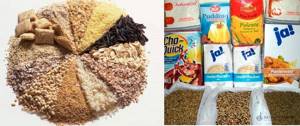
Feeder fishing is possible without the use of expensive store-bought mixtures at all. However, good professional baits can be added little by little to the base - for the smell. One package is enough for several fishing trips. For example, a loose base - crackers and cake. In this homemade feeder bait, add rolled oats ground in a coffee grinder during the current for greater stickiness. And to loosen it, add bran.
As a feed fraction, we cook millet, pearl barley, peas or add corn. The main thing is the final consistency. The correct ratio of parts and hydration will come with experience. For complete beginners, you can use a purely store-bought base at first, preferably without obvious strong odors - some kind of station wagon, vanilla, strawberry.
Among the supplements advertised on YouTube, we recommend molasses - it’s a really useful thing. Especially for those with a sweet tooth like bream, crucian carp or carp. If you don't have time to cook porridge, you can simply add sugar to it. If we add aroma to natural baits, it is only a little, for experimentation. This mixture already has its own aroma, attractive to fish. Various oils and vanilla, for example, are already added to the cookies that we ground into the base.

Animators and weights
For fishing in the current, clay, black soil, and soil from molehills can be added to the bait. At a strong flow, the content of such a weighting agent in the feed can reach up to 50%. Also important in the mix are elements like animators. This is all that creates certain visual effects in the water that attract fish.
The best and simplest animator is the living components in the food, which attract the fish with their movements. Floating pieces, husks, bran elements - all this attracts fish. Naturally, there should not be many of them. Dusty animators - flour, milk powder, create changing outlines of clouds of turbidity at the bottom. Mud, for example, attracts roaches well. But on the contrary, it is not needed for bream. Bream need large food particles lying on the bottom at one point.
Read more about feeder bait for bream.
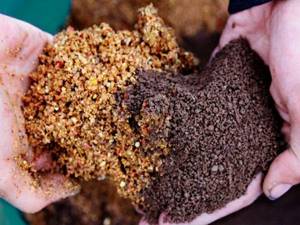
Adding sieved soil for weighting
Main components of bait
There are a lot of them, but when choosing a mixture, you need to take into account the feed ratio. He talks about how soon the fish will become saturated, based on the composition of the bait.
This indicator could be:
- short
- average
- high
The most common bait compositions are filled with:
- ground crackers, suitable for almost every feeding. They have good absorption of water and flavoring substances and are considered the main component of baits with an average feed ratio. Complementary foods can contain up to 60% of this component
- ground liver, which wonderfully attracts white fish species, with a specific gravity of up to 40%. Water absorption is quite high, binds the entire composition well, attracts and feeds fish, with a high feed ratio
- corn flour, which gives a viscous consistency and improves color and taste, is suitable for almost all fish, works as a binding component in the mixture, has a low feed ratio with a specific gravity of about 15%
- ground corn, which has a low feed ratio . Included in the bait mixture is 30%
- sunflower cake for flavoring, improving taste and color, attracting white fish. Buoyancy properties are good. It has an average feed ratio and is included in bait in amounts up to 30%
- roasted sunflower, which flavors the mixture, makes the mixture more viscous and tasty, supplementing it by 20%
- hemp seeds – roasted whole and roasted ground. Whole ones serve to ensure high floatability of the particles; ground ones add flavor. In the composition of the bait mixture they reach up to 10% and have an average feed value.
In addition, the compositions of many baits can be supplemented with:
- ground roasted peanuts
- ground soybean
- oatmeal
- fishmeal
- powdered milk
- sunflower seed husks
- sugar
- salt
- granulated bird and fish food (compound feed)
- various cereals
- bloodworm
- maggot
Animal component
When feeder fishing with animal bait, the same organisms used for fishing are used in the stern - worms, maggots, bloodworms. Such an additive is expensive - it is unlikely that anyone, unless he is an athlete, will pour a kilogram of maggot or worm into the bait. You can do it differently: chop a small amount of worm or put maggot waste (live, drowned, boiled, caster) on top of a bucket with bait.
When recasting, simply add worms a little at a time to the feeder. This kind of heating is especially important when a large fish has already approached and is biting, so that the school lingers at the point. And as the bulk of the feed we use the same barley or millet.
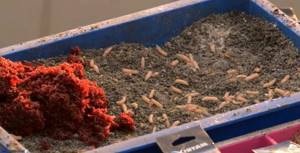
A classic feeder workplace for feeding
Groundbait for flat feeder
Loose bait is not suitable for flat feeders. The food should not collapse when cast and hit the water. For flat fishing, stickier baits or special fine-grained feeding pellets are used. Despite the stickiness, when it gets into the water, the mass should still collapse in time and release the bait stuck in it. Read more about groundbait for flat feeders.
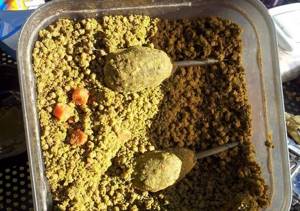
Ready mixes
As already mentioned, you should not take a package of store-bought bait as a product ready for fishing. This is just the basic framework. Its use in its pure form works, by and large, only to attract fish, and not to retain it. When hunting large fish, you need to add about 40% of the feed, coarse fraction. Athletes use store-bought bait as a whole cycle, mixing several different bags in a bucket. Some as a base, others with a larger faction. But even when targeting large fish, they add whole grains or an animal component.
We will not present a rating of feeder baits - this is useless work. There is no universal mixture for all occasions. The industry is simply trying to get anglers used to buying ready-made solutions. For some, this is convenient – especially for rare trips to a body of water. Feeder baits Sensas, Traper, Dunaev and others are popular. The same ones from YouTube videos from athletes. However, with frequent trips it is expensive for an amateur. It's easier to build your own system. For example, cooking porridge (the same salapinka), or creating a large supply of dry base, with which you can then carry out some manipulations.
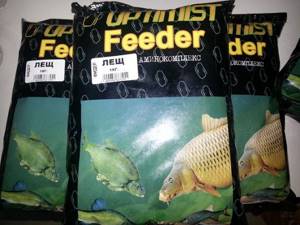
Amino complex
Good store-bought bait can be added to your homemade base as a flavoring and amino complex. Next, we will analyze the basic options for how to properly prepare bait for the feeder yourself, for amateur fishing.
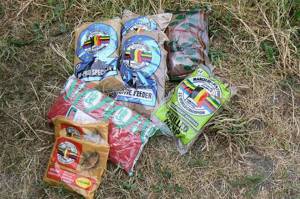
Making your own feeder bait
This suggests two directions for making homemade bait for the feeder. You can make the mixture completely ready for use at home. This is true when a body of water is nearby and there is not a long road ahead. Another option is a separate dry base and boiled feed additive (millet, pearl barley, peas). It is mixed and brought to the desired consistency already on the pond. Over time, each angler develops his own specific bait recipe for the feeder. The main thing is that the requirements for consistency and stern are met.
The simplest basic recipe for baiting a feeder made from rolled oats, which can be mixed in a pond:
- Hercules (both binder and feed fraction) – 40%.
- Breadcrumbs and finely ground sunflower cake (makukha) in different ratios to each other - 40%.
- Bonduelle corn – 1 can (20%).
- A packet of vanilla or cinnamon.

The main thing is to finally get the desired crumbly consistency, but with the ability to mold. Accordingly, if we fish with pearl barley, we add this boiled grain instead of corn. The same amount of pre-cooked millet or peas is also suitable. Pour the corn out of the jar along with the liquid. Together with the moisture of the porridge, this may be enough to moisten the bait. If not, add water from the reservoir.
The main thing is not to overdo it with water, especially if there are no dry ingredients in stock to add in case of excessive waterlogging. After half an hour the mass will swell and be ready. At this time, you can start measuring the bottom. When fishing with a worm or maggot, we add these animal components to the feeder.
There are countless recipes for do-it-yourself bait for a feeder on a similar basis - each fisherman will add something of his own that is more convenient for him or more relevant on a particular body of water. But millet, corn or pearl barley, crackers and cake are universal options that work almost everywhere. Hercules is needed for swelling, stickiness and absorption of excess moisture. We experiment with consistency and hydration, depending on the strength of the current in the reservoir.
Those fishermen who fish often and a lot build a whole system for making bait, stockpiling components in large quantities at home (so as not to run to the store before each fishing trip). You can prepare dry bait for the feeder feeder in large quantities at once and store it in a bag in the pantry, taking a little for each fishing trip. For others, it is more convenient to cook porridge and mix it with the base immediately, bringing the ready-made mixture to the pond.
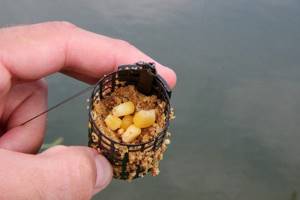
Homemade dry base
Preparing bait for the feeder at home does not take much time. At one time you can make a lot of mixture, which will be enough for more than one fishing trip. Ingredients vary based on ingredients available by region. Basic ones can be found everywhere in farm animal feed stores, magnets and Pyaterochka stores. There is no single recipe for dry bait for a do-it-yourself feeder. There are also special ratios in the component composition. Let's add what we have. But there are some patterns.
Most of all, by weight, you need to add neutral components that do not stick together when moistened - crackers, mixed feed, mixtures for feeding poultry from grains. We also add finely ground cake and oatmeal - but in smaller quantities, since these substances have adhesive properties. This is an excellent option for budget bait for a do-it-yourself feeder. The result is no worse than store-bought mixtures, but several times cheaper. And special additives, aroma, sweeteners can be added later - during kneading.
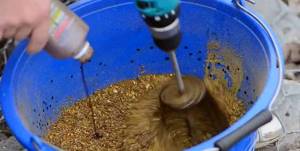
Approximate weight distribution:
- Feed mixture for poultry – 4 kg. It is quite fine, but you can also grind it on a fine grinder (if possible) to make the mass homogeneous.
- Ground rolled oats (flour) – 0.5 kg.
- Corn grits (small) – up to 1 kg.
- Ground peas, millet, yachka (coffee grinder) – up to 1 kg of each cereal. If you pre-millet the egg and fry it in a frying pan, then in ground form they no longer have adhesive properties.
- Breadcrumbs, crushed remains of dry bread, loaves, rolls - whatever you have, up to 5 kg.
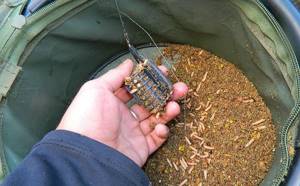
In this way you can get up to 15 kg of the base mixture for ridiculous money. If desired, this composition can be enriched:
- Any finely ground cereals, chickpeas, buckwheat, rice.
- Ground aromatic seeds - flax, hemp, dill, coriander.
- Ground peanuts.
- Cinnamon.
If it sticks too much when moistened, add bran or crackers. Too porous and does not mold - semolina, flour, finely ground cake. Thus, after several experiments with proportions, we obtain a universal base that will serve for years. Before fishing, we cook some porridge (millet, corn, pearl barley) for the feed fraction - 1 kg. We take the same amount (approximately) for the base reservoir. This is for approximately 2 kg of bait. The ratio may vary between anglers.
Feeder porridge
The so-called porridge for the feeder is essentially the same - the base base plus the feed fraction. It's just getting ready all at once. Millet bait for the feeder is the most commonly used option. Millet is cooked in a large amount of water, but not completely. Then the water is drained and the porridge is washed in cold water. Add a mixture of crackers, cake and other powders to the porridge and bring it to the desired consistency. Then you can add flavorings. Corn porridge for feeder fishing is cooked using the same principle.
Bait on a feeder made from corn grits or millet is medium-fraction - due to the small size of the grains. If you need a larger fraction, cook pearl barley. A universal option is the famous Salapin porridge, which is prepared using several grains at once. As a result, the composition contains feed particles of various sizes. More details - Salapin porridge for feeder.
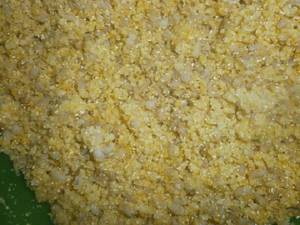
Salapinka
Pea porridge for feeder fishing is more viscous. To do this you will need regular pea halves. It is boiled into puree, and the bulk base is mixed with this mass. For greater stickiness, add semolina to the mixture. It turns out almost like mastyrka, only looser. All fish love peas. Moreover, on some reservoirs only peas work.
When fishing for large fish, you also need to find whole, unshelled peas. It also needs to be boiled and used as a bait, adding it to the bait for large feed fractions. Sometimes this is an indispensable combination for summer fishing for carp, crucian carp and large bream on a feeder. Learn more about how to cook peas for feeder fishing.
Recipe for making bait for the feeder
There are many options for preparing bait at home. Usually these are combinations of corn and wheat flour with ground seeds, cake, and breadcrumbs. Often breadcrumbs are replaced with ground rye and wheat breadcrumbs left over from breakfasts, lunches and dinners. For better “dusting”, semolina, corn, barley, and ground oatmeal are added, and for a sweet smell and taste, as already mentioned, ground gingerbread and cookies are added to the bait.
as a filler , in this case the famous “Salapin” porridge. To prepare it you will need: four and a half mugs of water, half a mug of pearl barley, a mug of millet, the same amount of barley grits and one and a half mugs of corn grits. Add a packet of vanillin and 2 tablespoons of unrefined vegetable oil to the porridge.

In an aluminum bowl, cook the pearl barley until tender, then add the millet and cook for three minutes. After this, add vanillin and oil. Turn off the heat and wait for the porridge to swell. Then add corn and barley grits. That's it... The porridge is ready. The rest of the finishing of the bait is done on the river.
Share with your friends!
Features of feeding fish with a feeder
Whether the bait for the feeder is made with your own hands, or is it a store-bought mixture, without proper and deliberate use you will not get an impressive catch (unless you get caught in the zhor, when everyone and everything bites). Each body of water, fishing conditions and type of fish determine the specific use of bait, its composition and scheme of application on feeder gear.
Bream
If you use feeder bait with your own hands, we focus on peas or millet. This fish does not tolerate any chemicals and loves natural ingredients. In the vast majority of cases, bream fishing occurs on rivers with fairly strong currents and impressive depths. Hence the requirements for bait for the river on the feeder - you need a heavy, large-component mixture. The presence of tasty feed particles is a must.
Adding animal components to the composition when fishing with a worm or maggot using a feeder is necessary. The feeding spot is made compact - the feeder is always thrown in one place, with an error of no more than 1 meter. The bait for bream should lie on the bottom and gradually be washed away by the current. The presence of highly dusty and floating components is not allowed. Read more about the features of feeder bream fishing.
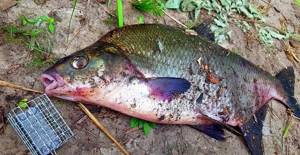
Crucian carp on the feeder
This fish is unpredictable in its tastes. Crucian carp lives everywhere - both in ponds and in rivers with a current. The consistency of bait for crucian carp is selected depending on the fishing conditions. Crucian carp can behave like bream - in large rivers, and react only to natural aromas. In other bodies of water, this fish sometimes readily responds to chemicals, and sometimes to completely strange odors - kerosene, garlic, WD-40, mosquito repellent.
It may take more than one fishing trip to figure out what the silver glutton prefers. In addition, the tastes of crucian carp are not stable over time. Today he eats a worm, and tomorrow he serves corn with maggots, flavored with garlic. On stagnant reservoirs, crucian carp responds well to flat feeders, boilies, pellets and mixed feed. Accordingly, we add what the silverback eats to complementary foods as a feed fraction. Read more about catching crucian carp using feeder gear.

Roach
This fast fish, scurrying everywhere in search of food, responds to constant supplementary feeding with fine, dusty bait. The roach feeder feeding strategy works for all small and medium-sized whitefish - white bream, silver bream, blue bream, white-eye. Large roaches are more serious - they still need food particles at the bottom, sometimes even peas or corn. We feed the roach often, but little by little, to maintain interest.
If we make a large cloud in the current that is carried away by the current, then the roach will follow it away from the fishing point. Feeder fishing for roach is sporty and difficult. This fish often does not swallow the bait, but swims away, holding it with the tip of its mouth. Therefore, hooking with a feeder does not lead to anything. You need to select the keys for the roach - groundbait, bait, leash length, hooking moment. Feeding a fishing point with a roach feeder means constantly throwing in small doses of food. A looser mixture may be needed so that the particles are washed out in the water column when the feeder lands.
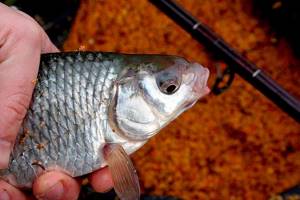
Carp and carp
You need to mix the bait for the feeder for carp or carp in the same way as you prepare food for yourself. These gourmets love to eat delicious food. Errors in aromatics will discourage baleen from visiting the fishing point for a long time. Carp need large, tasty feed elements - worms, corn, pellets, boilies. You need to feed a lot, especially in summer.
If the fish is actively feeding, it is easy to tempt it to bite, the main thing is to get into the place. But in the summer, when the thick-sided gluttons are glutted due to the abundance of natural food, the fisherman needs to try to offer the carp something tasty, sweet and visually attractive. The river carp uses a classic feeder, while the main gear for pond carp is a flat fish with boilies and pelets, as well as appropriate bait.
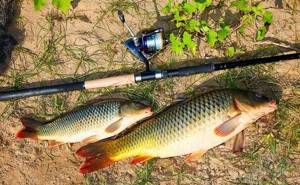
Subscribe to the channel:
YouTube channel RYBAFAN
We are VKontakte
What should you consider when making bait?
An important condition for a properly prepared bait mixture is the presence of a good smell and the fulfillment of the following conditions:
- oatmeal, dry clay, and egg powder are used as cementing ingredients
- The friability of bait is imparted by adding maggots, worms and other baits of animal origin
- dry ingredients added to complementary foods form turbidity: milk, daphnia, small sawdust
- Cake and fried sunflower seeds flavor the composition and lure the inhabitants of reservoirs.
DIY bait for high water fish
This bait composition should:
- hold tightly in a lump when clenched into a fist and be easily thrown 5-7 m.
- while touching the surface of the water surface, slowly lie down to the bottom
DIY bait for deep-sea fish:
- hold tightly in a ball, when clenched in a fist, and throw it at a distance of 10-20 meters
- if fishing occurs on rivers with current, the scattering of bait is carried out exclusively when touching the bottom.
Bait for large, cautious fish in the current
Large fish that react cautiously to bait will devour the bait if it sinks to the bottom surface, forming a continuous cloud without turbidity. This mixture should be fed generously, but at certain intervals.
Bait for roach or perch, or small silver bream and white bream in mid-water or above the bottom
In this case, bait mixtures should have the ability to create a scattered cloudy spot in the middle layers of water. This effect can be achieved by tossing small lumps of complementary food before the next recast.
Bait for catching bleak in surface layers and in shallow water
For this fish you need:
- make the top dressing very liquid, giving a persistent cloudy cloud consisting of milk powder, small crackers, oatmeal and egg powder
- large bleak is found in deep water, almost at the bottom, and it is advisable to feed it with weighted bottom bait
All of the above bait mixtures are suitable for fishing from the shore. When fishing from a boat, you need to place the bait in a net with small cells. The bait should be of a dense consistency to avoid rapid washing out.
